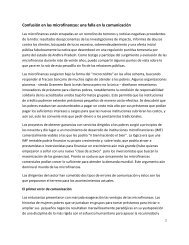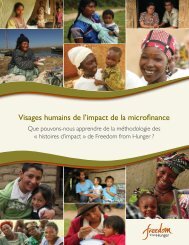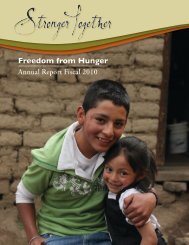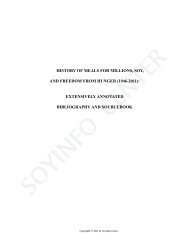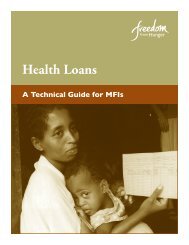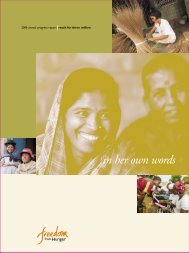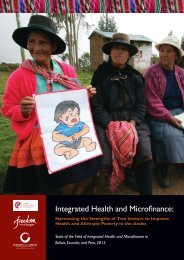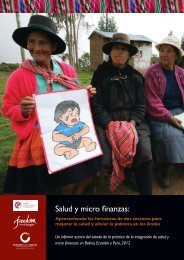Strengths, Weaknesses and Evolution of the Peace Corps' 11-Year ...
Strengths, Weaknesses and Evolution of the Peace Corps' 11-Year ...
Strengths, Weaknesses and Evolution of the Peace Corps' 11-Year ...
You also want an ePaper? Increase the reach of your titles
YUMPU automatically turns print PDFs into web optimized ePapers that Google loves.
savings at home. However, <strong>the</strong> members said that <strong>the</strong>y prefer to save in <strong>the</strong> community bank<br />
because it does not permit <strong>the</strong>m to easily access <strong>and</strong> spend <strong>the</strong>ir money, <strong>and</strong> <strong>the</strong>y enjoy <strong>the</strong><br />
friendship <strong>and</strong> activities that come with participation in <strong>the</strong> community bank.<br />
The community bank members consider <strong>the</strong> most important advantages <strong>of</strong> <strong>the</strong> PAC to be<br />
friendship <strong>and</strong> support from fellow community bank members, disciplined savings <strong>and</strong> easy access<br />
to loans. The members in Loja consider one <strong>of</strong> <strong>the</strong> primary disadvantages <strong>of</strong> <strong>the</strong> community banks<br />
to be a lack <strong>of</strong> underst<strong>and</strong>ing about how to manage <strong>the</strong>ir groups, particularly <strong>the</strong> accounting <strong>and</strong><br />
general administration. The research team in Bahía <strong>and</strong> Loja also noted a lack <strong>of</strong> transparency <strong>and</strong><br />
structure to <strong>the</strong> meetings.<br />
While some community banks are formed by trained <strong>Peace</strong> Corps volunteers <strong>and</strong>/or trained local<br />
counterparts, <strong>the</strong>re is a very high percentage <strong>of</strong> groups in Bahía that were spontaneously formed by<br />
untrained community members or replicators.<br />
In conclusion, <strong>the</strong> strengths <strong>of</strong> PAC are <strong>the</strong> significant financial <strong>and</strong> social benefits that members<br />
receive through participation. They include disciplined savings, easy access to loans, <strong>and</strong> friendship<br />
<strong>and</strong> support from community bank members. The weaknesses <strong>of</strong> <strong>the</strong> PAC are <strong>the</strong> general lack <strong>of</strong><br />
transparency <strong>and</strong> good management <strong>of</strong> <strong>the</strong> accounting, <strong>and</strong> <strong>the</strong> lack <strong>of</strong> structure in <strong>the</strong> meetings,<br />
particularly in replicated groups. The PAC has evolved over time <strong>and</strong> members are managing larger<br />
amounts <strong>of</strong> money, changing <strong>the</strong> original rules to better meet <strong>the</strong>ir needs <strong>and</strong> engaging in additional<br />
activities <strong>of</strong> <strong>the</strong>ir own volition.<br />
Based on <strong>the</strong> results <strong>of</strong> this study, <strong>the</strong> recommendations for both <strong>Peace</strong> Corps Ecuador <strong>and</strong> o<strong>the</strong>r<br />
Savings Group programs in Latin America are to<br />
1. streng<strong>the</strong>n <strong>the</strong> Savings Groups’ ability to manage <strong>the</strong> meeting agenda steps, accounting <strong>and</strong><br />
internal rules;<br />
2. develop <strong>and</strong> widely disseminate a few concrete best practices that good Savings Groups must<br />
follow, particularly to replicated groups;<br />
3. develop Savings Group programs that can accommodate flexible financial rules <strong>and</strong> help<br />
members to develop <strong>the</strong> skills to manage <strong>the</strong>m;<br />
4. provide training to Savings Group members on how to open <strong>and</strong> manage commercial bank<br />
accounts as a group when <strong>the</strong>y have access to <strong>the</strong>m;<br />
5. provide training to Savings Groups on how to distribute efficiently <strong>and</strong> transparently,<br />
particularly for groups that are saving different amounts;<br />
6. integrate o<strong>the</strong>r development activities such as training on priority topics early on into <strong>the</strong> Savings<br />
Group program that will help members better meet <strong>the</strong>ir needs;<br />
7. create Savings Group programs that target youth in order to better meet <strong>the</strong>ir needs <strong>and</strong> develop<br />
<strong>the</strong>ir skills both in financial services <strong>and</strong> o<strong>the</strong>r development areas such as training on priority<br />
topics; <strong>and</strong><br />
8. develop a replication strategy that helps communities to responsibly replicate Savings Groups<br />
<strong>and</strong> consider how to utilize existing resources in <strong>the</strong> communities, namely leaders <strong>of</strong> strong<br />
existing Savings Groups.<br />
While rigorous impact studies are being conducted in Africa on Savings Group programs, it is<br />
recommended that rigorous research be conducted in order to better underst<strong>and</strong> <strong>the</strong> impacts <strong>of</strong> <strong>the</strong><br />
Savings Group programs in Latin America.<br />
<strong>Strengths</strong>, <strong>Weaknesses</strong> <strong>and</strong> <strong>Evolution</strong> <strong>of</strong> <strong>the</strong> <strong>Peace</strong> Corps’ <strong>11</strong>-<strong>Year</strong>l-Old Savings Group Program in Ecuador P a g e | iii



